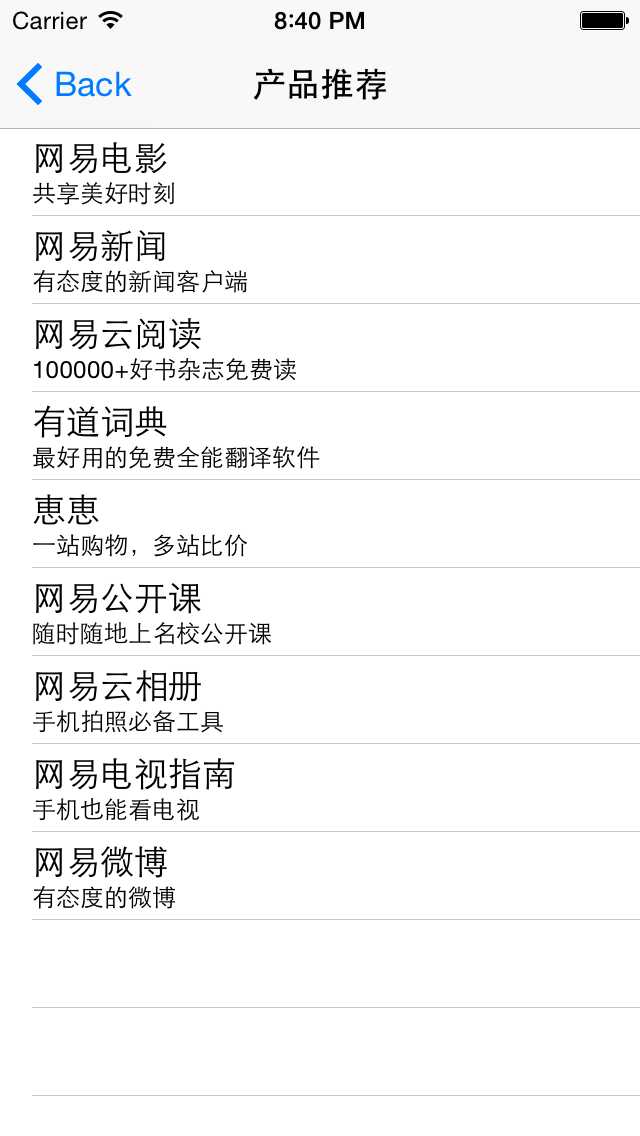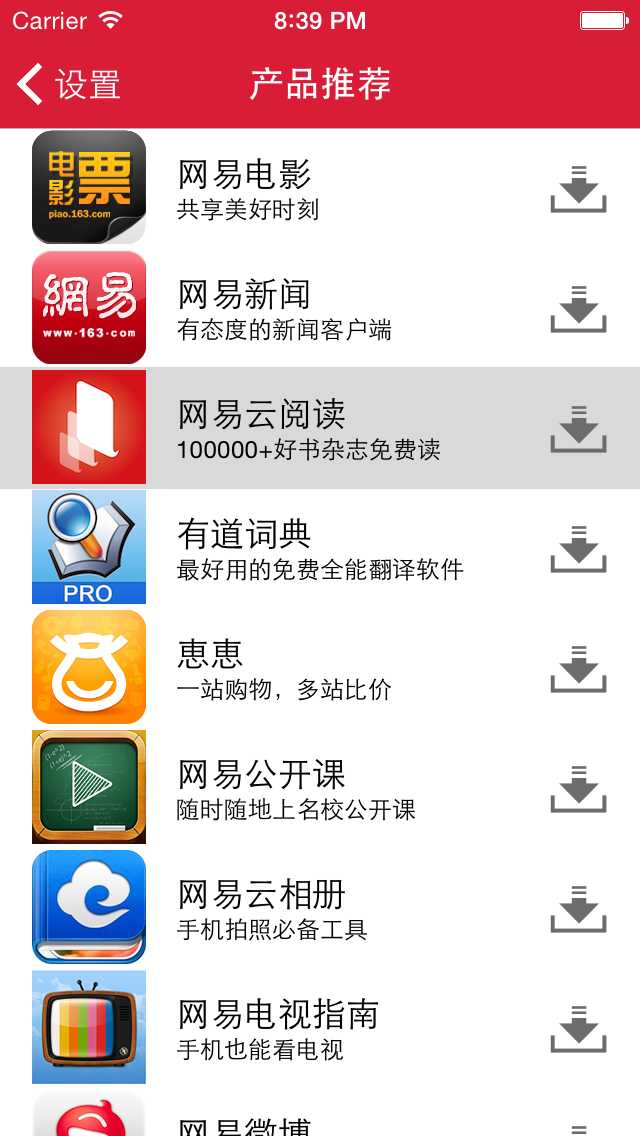标签:
产品推荐界面的实现
目前很多公司都仅仅只有一个项目,所以他们关于其他的项目肯定会做相应的推广,而在APp内部使用产品推荐实现APP的推广使一种很常见的现象,因为不需要什么成本,所以今天就简单介绍一下这么去搭建一个简单的产品推荐界面。
本章重点:
好了下面就来看看关于产品推荐界面是怎么去实现的!
1:JSON数据

2:对应的模型属性和模型方法(这里就不多介绍了)
1 @property (nonatomic, copy) NSString *title; 2 3 @property (nonatomic, copy) NSString *stitle; 4 5 @property (nonatomic, copy) NSString *ID; 6 7 @property (nonatomic, copy) NSString *url; 8 9 @property (nonatomic, copy) NSString *icon; 10 11 @property (nonatomic, copy) NSString *customUrl; 12 13 14 15 -(instancetype)initWithDict:(NSDictionary *)dict; 16 17 +(instancetype)productWithDict:(NSDictionary *)dict;
模型方法的实现
1 -(instancetype)initWithDict:(NSDictionary *)dict 2 3 { 4 5 if (self == [super init]) { 6 7 self.title = dict[@"title"]; 8 9 self.stitle = dict[@"stitle"]; 10 11 self.ID = dict[@"id"]; 12 13 self.url = dict[@"url"]; 14 15 self.icon = dict[@"icon"]; 16 17 self.customUrl = dict[@"customUrl"]; 18 19 } 20 21 return self; 22 23 } 24 25 26 27 +(instancetype)productWithDict:(NSDictionary *)dict 28 29 { 30 31 return [[self alloc] initWithDict:dict]; 32 33 }
3:自定义Cell
1 +(instancetype)cellWithTableView:(UITableView *)tableView 2 3 { 4 5 static NSString *ID = @"Cell"; 6 7 iCocosProductsCell *cell = [tableView dequeueReusableCellWithIdentifier:ID]; 8 9 if (cell == nil) { 10 11 cell = [[iCocosProductsCell alloc] initWithStyle:UITableViewCellStyleSubtitle reuseIdentifier:ID]; 12 13 } 14 15 return cell; 16 17 }
4:控制器中实现最基本的方法:
1 - (void)viewDidLoad { 2 3 [super viewDidLoad]; 4 5 6 7 self.title = @"产品推荐"; 8 9 10 11 } 12 13 14 15 #pragma mark - Table view data source 16 17 - (NSInteger)tableView:(UITableView *)tableView numberOfRowsInSection:(NSInteger)section { 18 19 20 21 return self.products.count; 22 23 } 24 25 26 27 - (UITableViewCell *)tableView:(UITableView *)tableView cellForRowAtIndexPath:(NSIndexPath *)indexPath { 28 29 iCocosProductsCell *cell = [iCocosProductsCell cellWithTableView:tableView]; 30 31 32 33 iCocosProductsModel *products = self.products[indexPath.row]; 34 35 36 37 cell.products = products; 38 39 40 41 return cell; 42 43 }
5:这里就是控制器中的重点,也就是JSON数据的加载和序列化,关于JSON数据的序列化详细请查看笔者之前写的:
我们使用一个可变数组,实现将JSON数据序列化出来的数组存放在里面方便后面的tableView代理方法直接使用,这里前面的MVC已经非常清楚了,
定义可变数组
1 -(NSMutableArray *)products 2 3 { 4 5 6 7 实现懒加载可变数组 8 9 if (_products == nil) { 10 11 _products = [NSMutableArray array]; 12 13 14 15 16 17 // NSString *urlPath = [[NSBundle mainBundle] pathForResource:@"more_project.json" ofType:nil]; 18 19 // 20 21 // NSData *data = [NSData dataWithContentsOfURL:[NSURL URLWithString:urlPath]]; 22 23 24 25 NSURL *jsonPath = [[NSBundle mainBundle] URLForResource:@"more_project.json" withExtension:nil]; 26 27 NSData *data = [NSData dataWithContentsOfURL:jsonPath]; 28 29 30 31 id arrdata = [NSJSONSerialization JSONObjectWithData:data options:0 error:nil]; 32 33 34 35 if ([arrdata isKindOfClass:[NSArray class]]) { 36 37 for (NSDictionary *dict in arrdata) { 38 39 iCocosProductsModel *products = [iCocosProductsModel productWithDict:dict]; 40 41 42 43 [_products addObject:products]; 44 45 } 46 47 } 48 49 50 51 52 53 NSLog(@"%@", _products); 54 55 } 56 57 return _products; 58 59 }
6:要现实数组,我就需要在自定义Cell中实现相应的数据显示方法
定义一个模型属性:
重写他的setter方法,设置对应的数据:
1 -(void)setProducts:(iCocosProductsModel *)products 2 3 { 4 5 _products = products; 6 7 8 9 self.imageView.image = [UIImage imageNamed:products.icon]; 10 11 12 13 self.textLabel.text = products.title; 14 15 16 17 self.detailTextLabel.text = products.stitle; 18 19 }
此时就可以简单的现实数据了:

关于图片为什么不显示,这里是一个需要注意的地方,平时开发中我们要根据需求来开发,比如在我们的json数据中图片都是有@2x.png的,但是Xcode有会默认帮我们在后面加上@2x.png,所以有的时候就可能导致图片不显示,这个时候我们就需要使用字符串的替换方法将@2x.png替换成空的字符串,当然你也可以使用其他的方法
1 NSString *imgName = [products.icon stringByReplacingOccurrencesOfString:@"@2x.png" withString:@""]; 2 3 self.imageView.image = [UIImage imageNamed:imgName];
7:然就要实现Cell中下载按钮的现实和业务逻辑的实现,这里说一下思路
所以这里我们在模型中新增一个两个属性
1:判断是否安装对应软件:
2:打开对应的URL
实现判断是否安装对应App的getter方法,传入模型中对应的值。
这里设置到了应用调整的知识,其实就相当去设备中的路径:scheme + :// + indentifer
使用上面传如的值结合单例UIApplication的canOpenURL方法判断是否可以打开(即是都安装对应的软件)
1 -(BOOL)isInstall 2 3 { 4 5 #warning 跳转应用 scheme + :// + indentifer 6 7 NSString *openUrl = [NSString stringWithFormat:@"%@://%@",self.customUrl, self.ID]; 8 9 10 11 self.openURL = openUrl; 12 13 14 15 // 应用已经安装 16 17 return [[UIApplication sharedApplication] canOpenURL:[NSURL URLWithString:openUrl]]; 18 19 }
8:然后在Cell实现下载或者打开按钮的现实和业务逻辑的实现:
首先在私有拓展中声明一个按钮的属性
然后懒加载按钮并且为按钮添加点击事件:
1 -(UIButton *)rightBtn 2 3 { 4 5 if (_rightBtn == nil) { 6 7 _rightBtn = [UIButton buttonWithType:UIButtonTypeCustom]; 8 9 10 11 [_rightBtn addTarget:self action:@selector(btnClick) forControlEvents:UIControlEventTouchUpInside]; 12 13 } 14 15 return _rightBtn; 16 17 }
下面就要实现第七点说道的两个重要的地方了,
1)设置按钮的图片
根据是否按钮对应的软件,在模型属性的setter方法中判断模型中的isInstall是否有值,如果有值就设置对应已经安装的图片(可直接打开),如果没有值酒设置下载按钮的图片,并且设置按钮自动适配大小
1 if (!products.isInstall) { 2 3 [self.rightBtn setImage:[UIImage imageNamed:@"appadcell_downloadbutton"] forState:UIControlStateNormal]; 4 5 } else { 6 7 [self.rightBtn setImage:[UIImage imageNamed:@"appadcell_openbutton"] forState:UIControlStateNormal]; 8 9 } 10 11 12 13 [self.rightBtn sizeToFit];
最后就是实现按钮的点击了,点击按钮做对应的额事情,可能是直接打开应用,也可能使转到App Store中对应的链接地址下载对应的应用(设置设计到了部分的真机知识,但是不足以去完全讲解一些真机相关的,关于真机后面的文章中会详细介绍)。
在监听按钮点击的方法中,判断对应的isInstall是否有值有酒打开应用,没有就转到App Store下载
1 -(void)btnClick 2 3 { 4 5 if (self.products.isInstall) { 6 7 [[UIApplication sharedApplication] openURL:[NSURL URLWithString:self.products.openURL]]; 8 9 } else { 10 11 [[UIApplication sharedApplication] openURL:[NSURL URLWithString:self.products.url]]; 12 13 } 14 15 }
最后我们会看到这样的界面

标签:
原文地址:http://www.cnblogs.com/iCocos/p/4733069.html